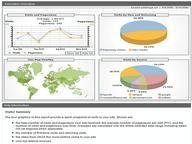Quiz Answer Key and Fun Facts
1. After church one Sunday, Shelly comes home and decides to make chocolate chip cookies. The bag she uses contains 200 chocolate chips, and she ends up making 20 cookies, which gives an average of 10 chips per cookie. She wants that first one she (randomly) chooses to be the perfect cookie--what is the liklihood that that first cookie will have at least 13 chocolate chips?
2. After some cookies, Shelly sits down on the sofa to watch the NASCAR race that she has been looking forward to all week. Her favorite drivers have always been the Labonte brothers, Terry and Bobby, and she's hoping that they both finish well in this race. If the race begins with 43 drivers, what is the (mathematical--pretending that no skill is involved) probability that both the Labonte brothers will finish in the top 10?
3. The Labonte brothers don't start too well in this particular race, but Shelly's interest is piqued at the first commercial break--she has three particular ads that she really enjoys. If there are 40 different commercials for the network to choose from in this programming segment, and the commercial break has 5 ads (no repeats), what is the probability that Shelly will see all three of her favorite ads sometime in the first commercial break?
4. Disillusioned by a disappointing first advertisment, Shelly gives up on the ads, and decides to go order a pizza. She has a coupon for a two-topping medium pizza at half-price. When the order boy asks "Which toppings would you like?" Shelly, feeling frisky, instructs him to surprise her, and choose the toppings for her. Twenty minutes later, she realizes with horror that she has forgotten to tell him that she is allergic to onions. There are 22 different pizza toppings at the pizzeria (only 1 onion topping)--what is the liklihood that Shelly will be able to eat her pizza?
5. The pizza turned out to have ham and green peppers on it--a good choice, Shelly thought. As she returned to watch the race, a commercial for the local Pick 4 lottery (in which one selects 4 numbers from 0 to 9 independently, hoping to match the lottery's 4 randomly chosen numbers--repeated numbers are possible) came on, stating that if someone were to get 3 of the 4 numbers correct, then he or she would receive 5 free lottery tickets. "I wonder what the chances are of that happening," Shelly wondered. What are they?
6. The Labonte brothers finished a disappointing 16th and 34th in the race. Shelly got up, thinking that it was time for some exercise after an afternoon of pizza and cookies. As she left to go running, she noticed that someone had run over the stop sign near her house again. On her jog, she counted the other signs in her neighborhood--5 stop signs and 21 others. "I figure stop signs, being at intersections, are twice as likely to get hit as other signs," thought Shelly. If her counting and thinking is correct, what is the probability that the next sign in her neighborhood that gets run over will be a stop sign?
7. As Shelly is stretching to cool down from her run, she notices something unusual--three of the doors across the street from her are painted blue. "How odd," Shelly thinks, "I wonder why I never noticed that before? That seems unlikely." If 10% of all homes have blue doors, and there are 15 townhouses across from Shelly's house, what is the probability that (exactly) 3 houses will have blue doors?
8. After showering off, Shelly notices the cookies that she made once more. Specifically, she notices one cookie that appears to have no chocolate chips. Upon further inspection, the cookie proves to have a couple chips in it, but that leads Shelly to wonder whether it's possible by pure chance to end up with a cookie with no chocolate chips at all (provided that she mixed the batter thoroughly). Is it?
9. Shelly decides to call it an early night, and to just do the laundry and turn in. Pulling her things away from the dryer, she fails to notice that she has left 2 socks in the machine. If that load of laundry had 10 pairs of socks (20 socks altogether) in it, what is the probability that all the socks that Shelly has in her basket will match?
10. After washing up, Shelly is getting ready for bed, when the weatherman reports that there is a 40% chance of rain tomorrow. As she lies down, she tries to remember which of her friends is driving her carpool tomorrow--Dave, Ben, or Sheila. "Ben's late half the time," thinks Shelly, "and I don't want to be waiting around in the rain while he takes his time." She considers calling Sheila, but decides just to take her chances instead, and rolls over and goes to sleep. What is the probability that she will get caught in the rain as she feared?
Source: Author
avrandldr
This quiz was reviewed by FunTrivia editor
crisw before going online.
Any errors found in FunTrivia content are routinely corrected through our feedback system.
